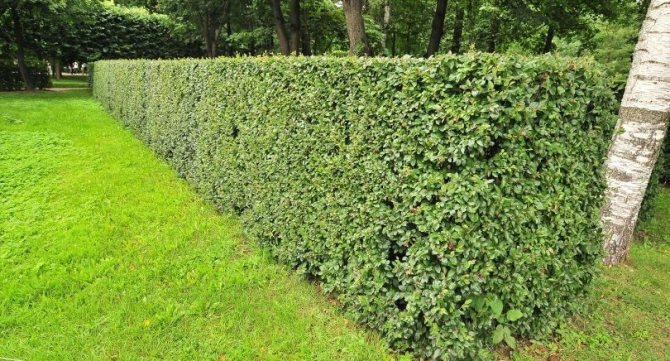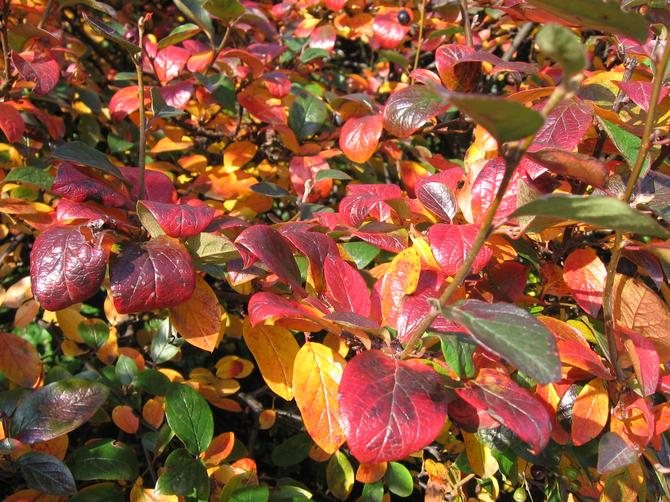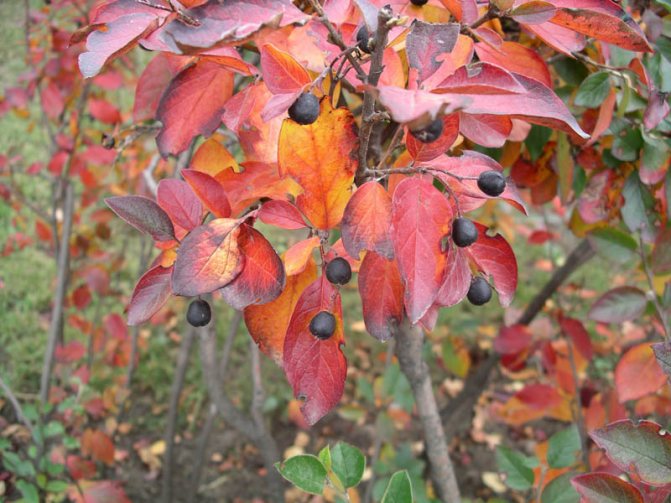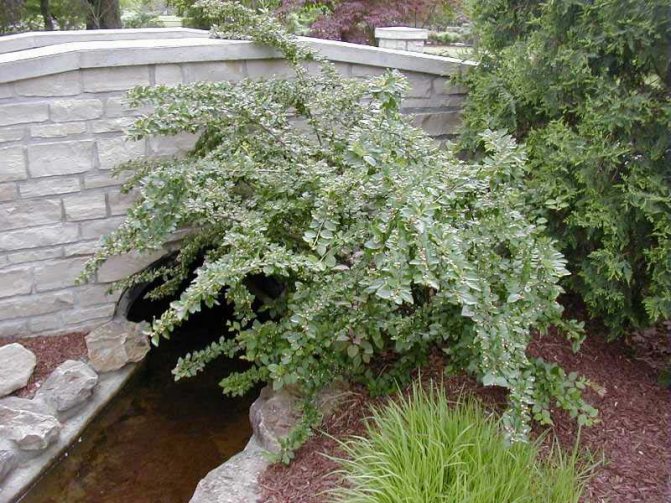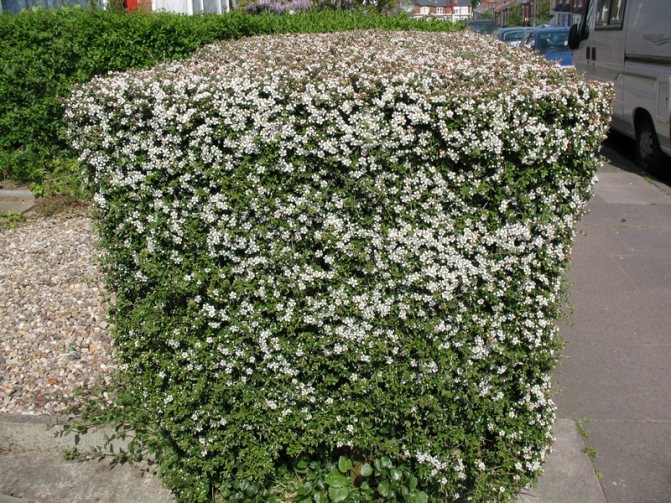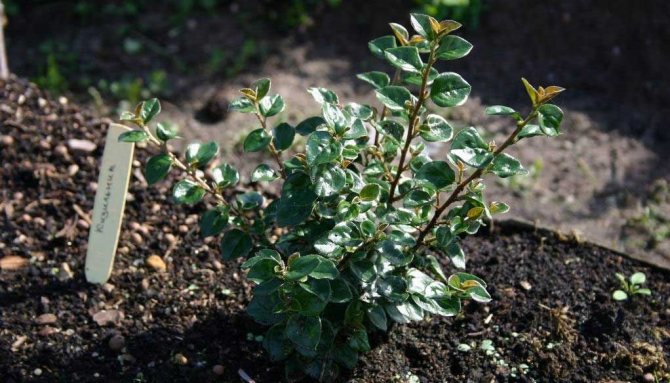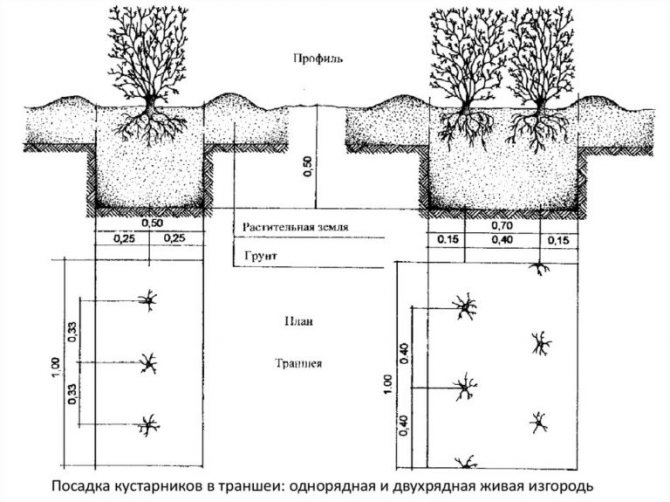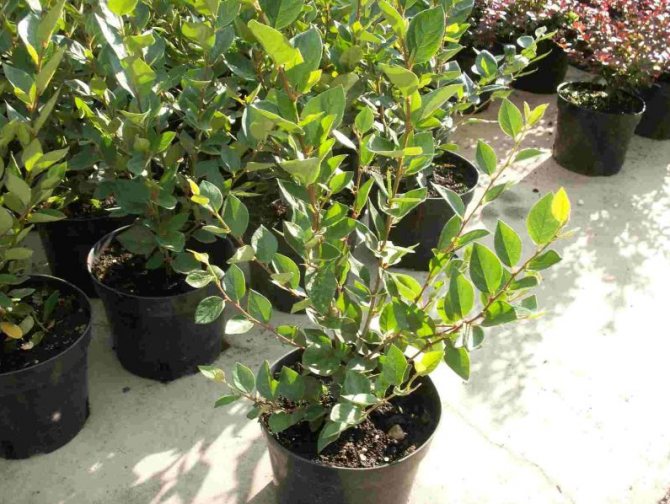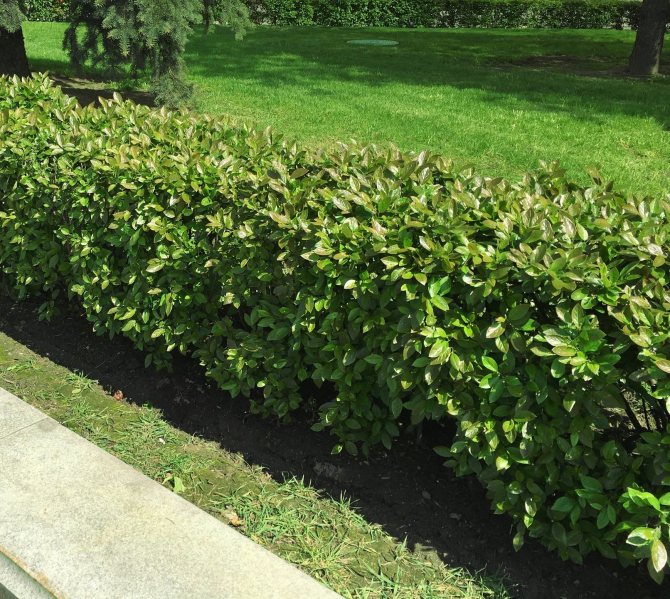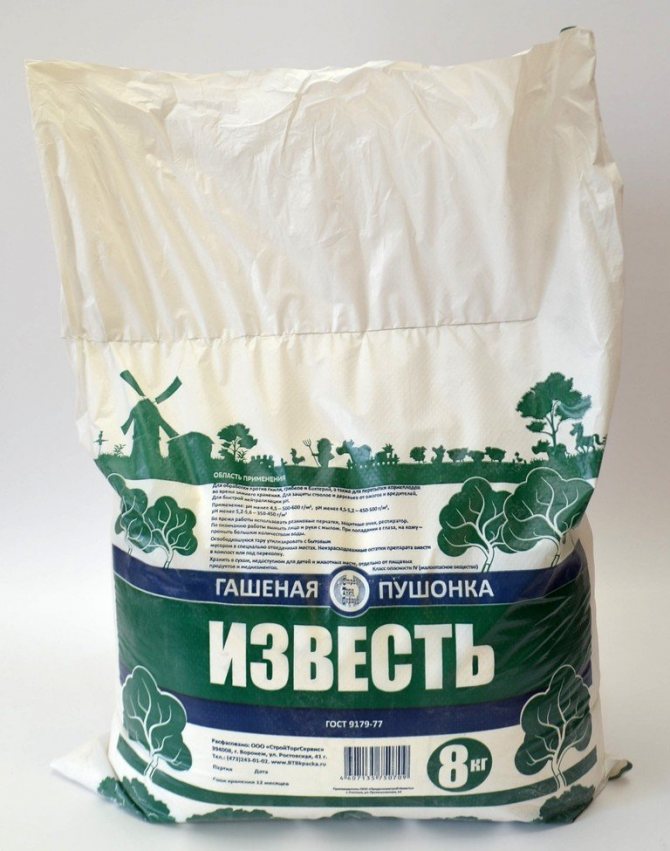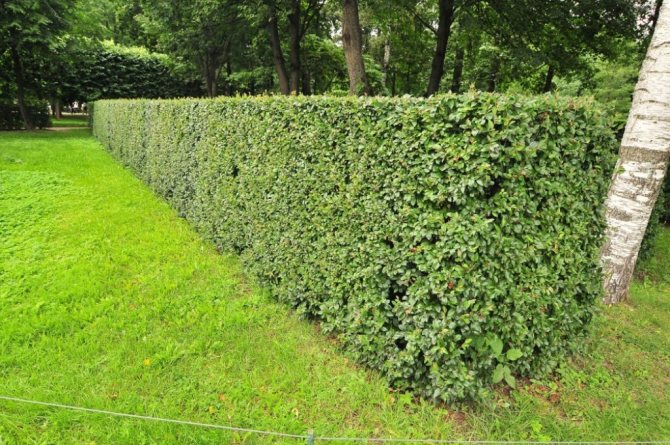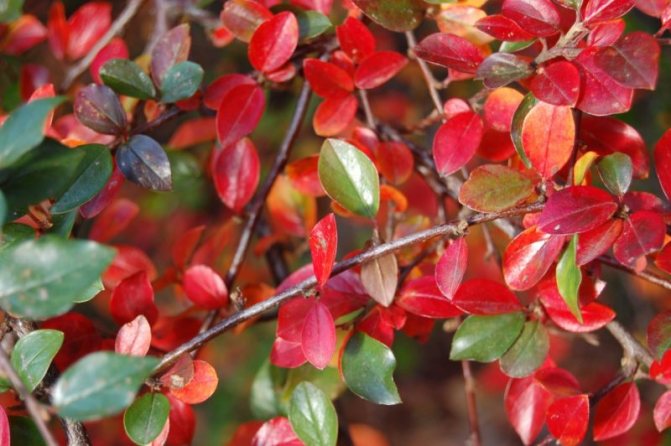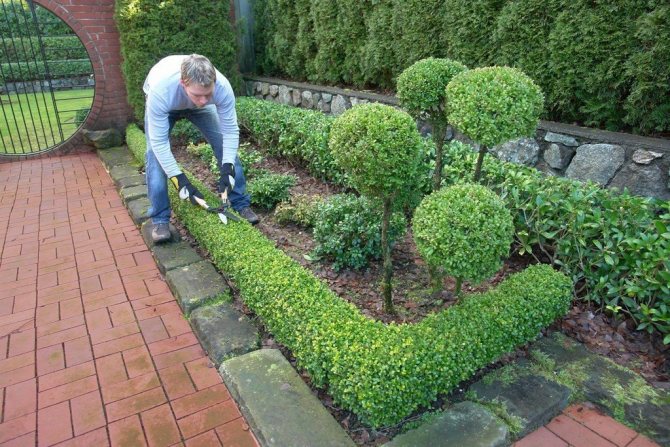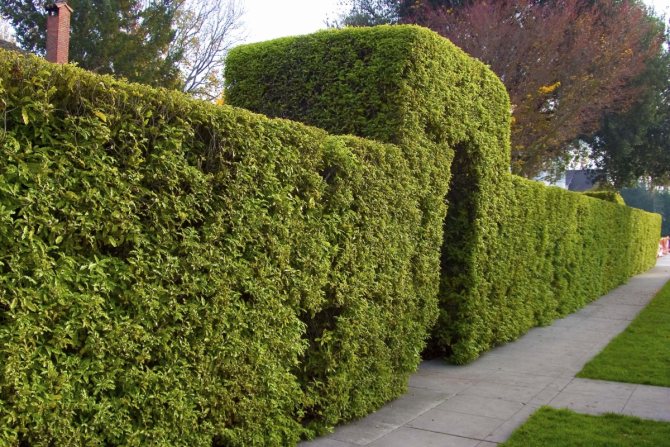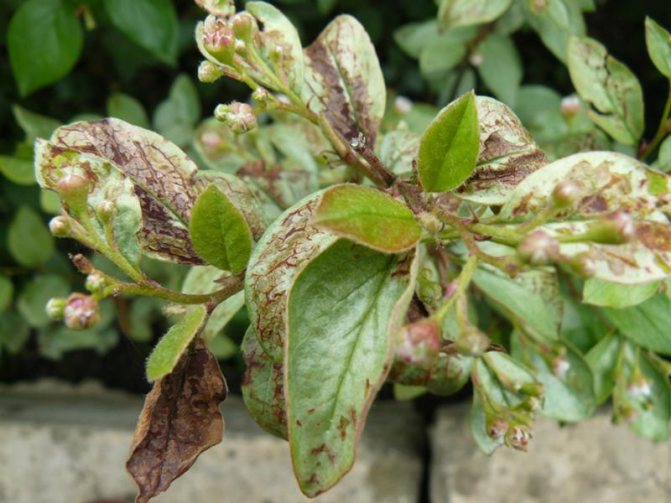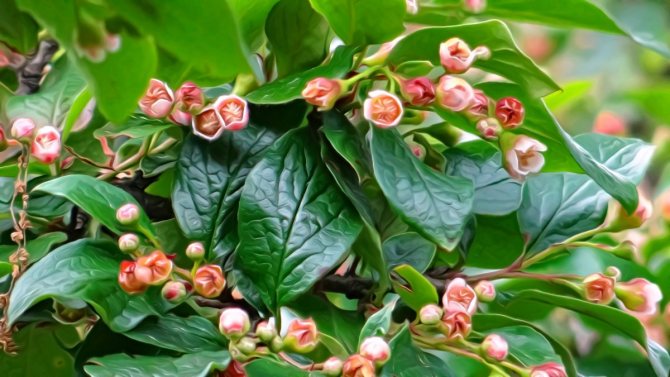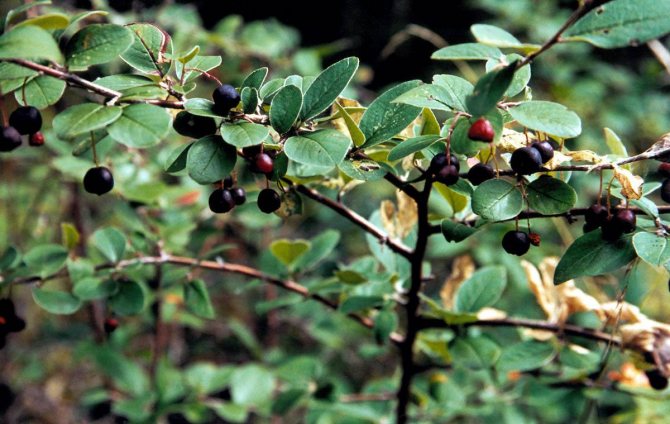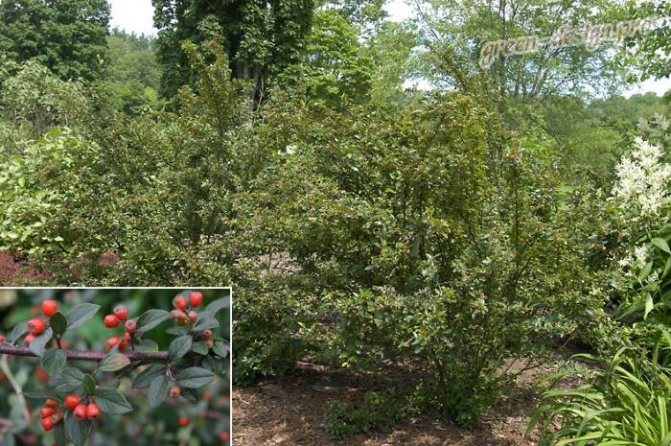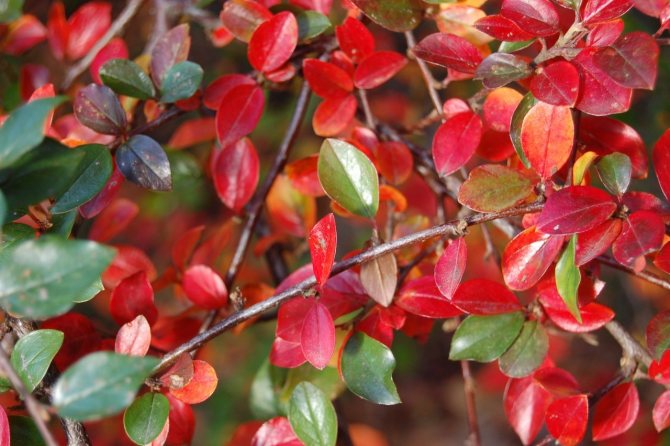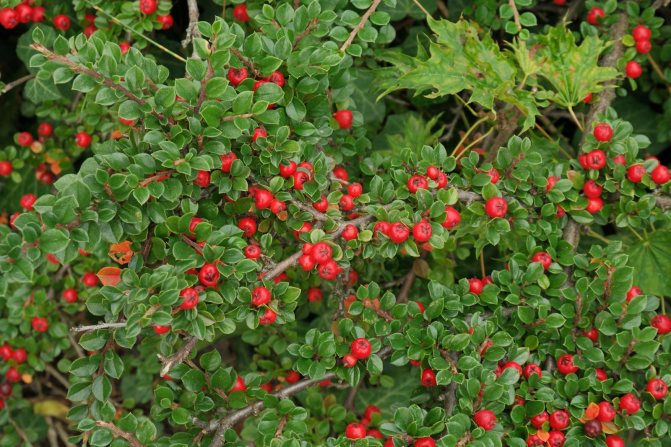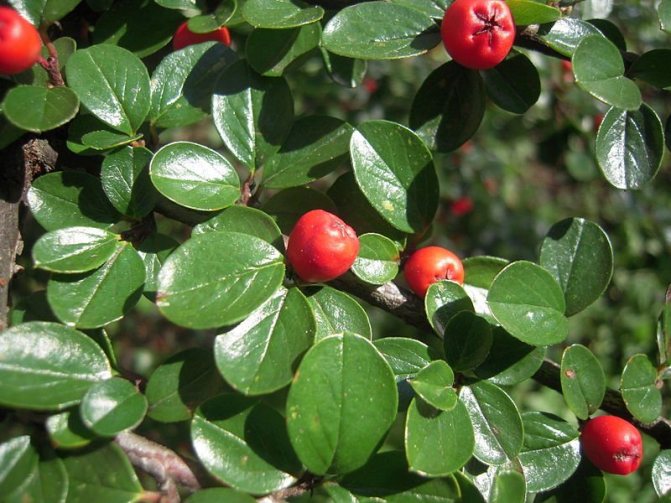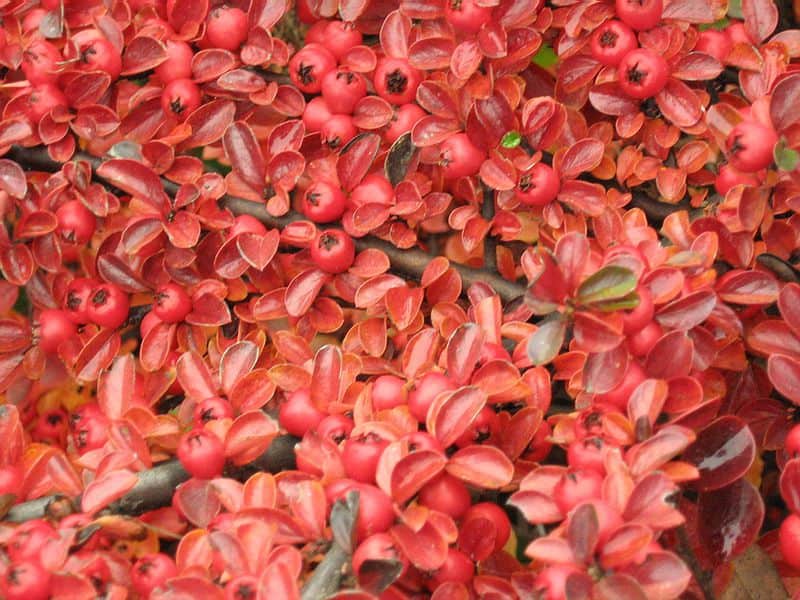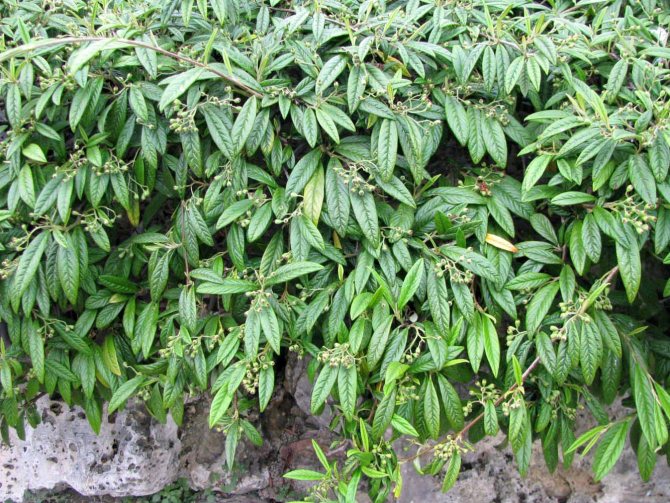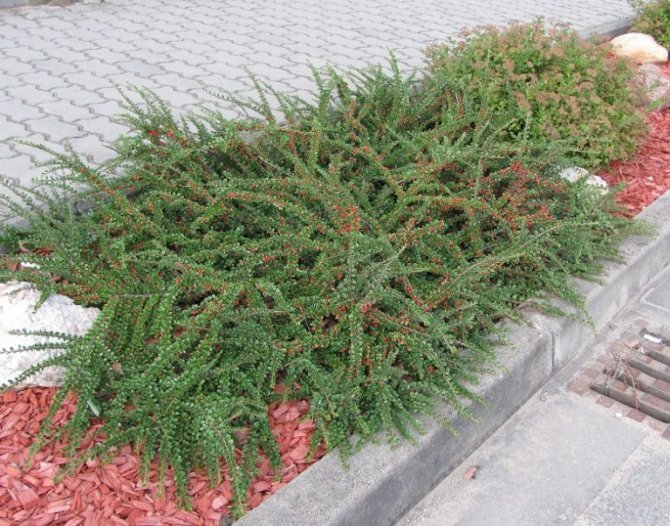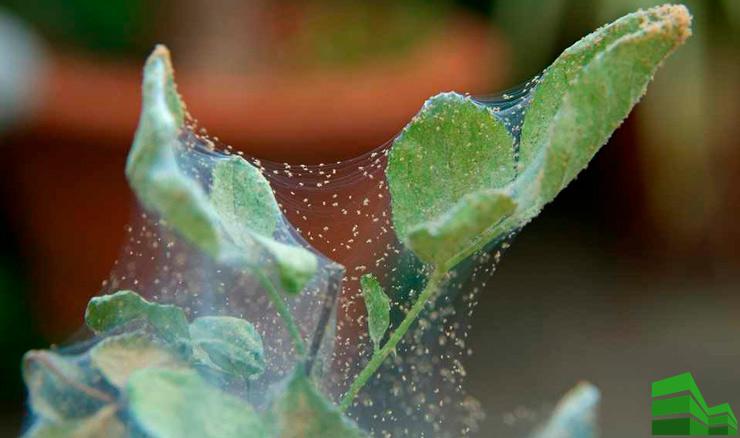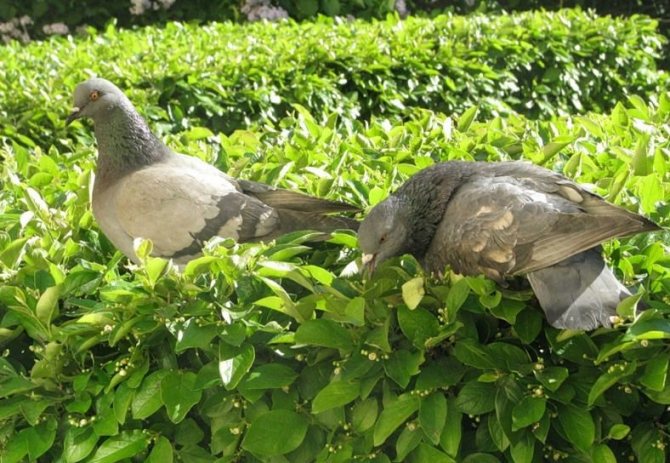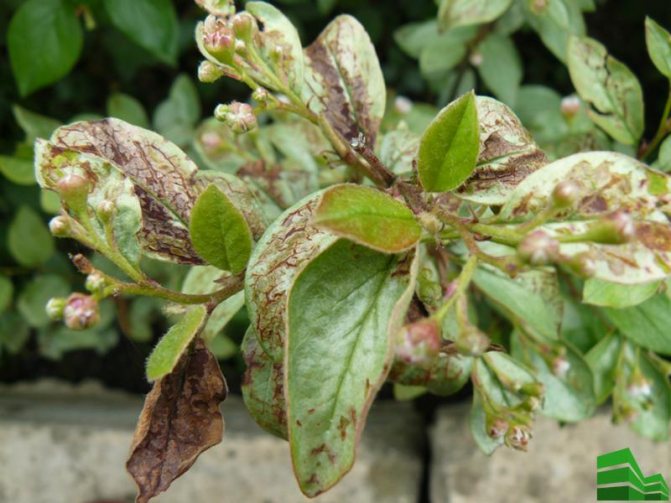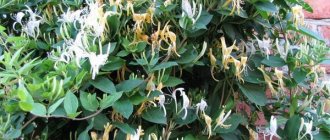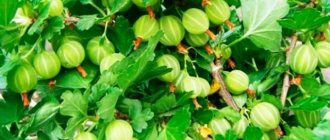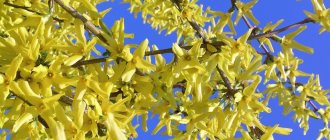Brilliant cotoneaster is a simple, unpretentious, but decorative and very common shrub in gardens and parks. Nowadays, thanks to the enthusiasm of the owners of summer cottages and plots with landscaping, it is more and more in demand in private gardens, to decorate the territory near cottages and in summer cottages, if the owners grow not only vegetables and fruits.
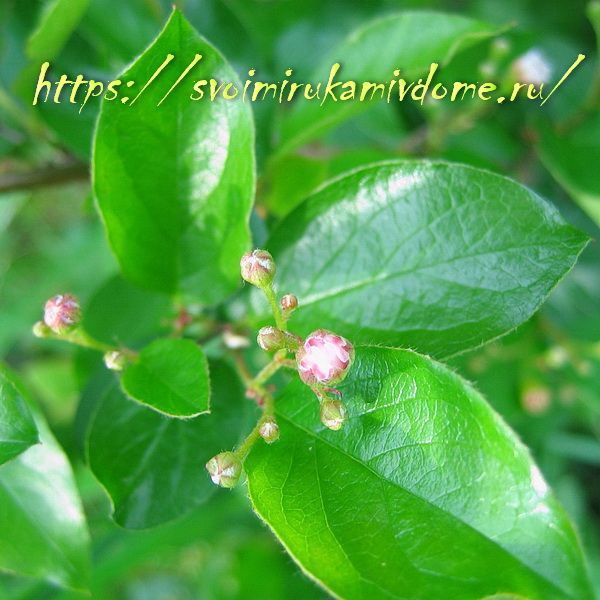
Buds on a cotoneaster shining
Shiny cotoneaster (Cotoneaster lucidus) is a deciduous shrub up to 2-3 meters high, upright, densely leaved with young pubescent shoots. Leaves are pointed, elliptical to ovate, shiny above, dark green, pubescent below in spring, later almost glabrous. In autumn, the leaves change color to a bright purple or orange. Flowers are small, pink, well-visited by bees and bumblebees, flowering in May-June. Fruits are black berries, ripen in autumn.
All types of cotoneaster, and there are about 40 of them, slowly grow and belong to the genus Cotoneaster of the Rosaceae family, among them there are evergreen species.
The brilliant cotoneaster grows wildly in Altai and is found in the north of China. In culture, it is distributed in the middle and northern zones of the European part of Russia and the countries of the former USSR, in the southern zone of the taiga in Siberia. It grows successfully in the northern regions, including St. Petersburg, Kirov, Perm, Yekaterinburg.
Cotoneaster shining in early May
The brilliant cotoneaster looks decorative in spring in a blooming state, in summer with dark green shiny foliage and in autumn with black fruits hanging on the branches until spring.
It is widely used in green building, especially for hedges that are regularly trimmed. It is considered one of the most suitable shrubs for this in the southern and middle parts of the northern forest zone of Russia, the central part of the forest-steppe zone of the European part of Russia and the countries of the former USSR, suitable for planting in the southern zone of the taiga, forest-steppe and steppe zones of Siberia and the southern part of the Far East.
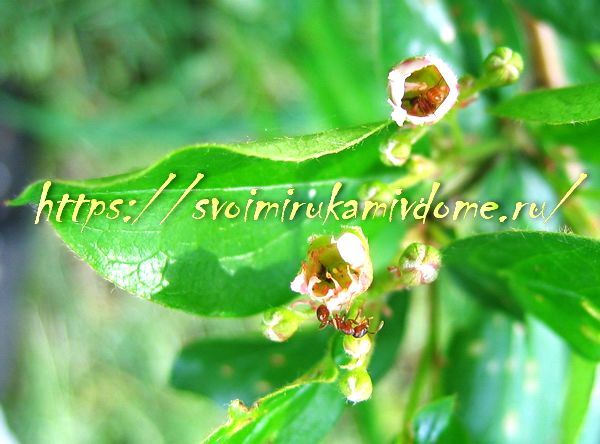

Shiny cotoneaster in bloom
Shiny cotoneaster also looks good in groups, forest edges and undergrowth, in the background in the mixborder and in the curb along the path, dwarf forms are good in rocky areas. Gas-resistant enough, therefore, it tolerates urban conditions well.
Perfectly tolerates cutting and shaping. It is possible to cut figures of various heights and configurations from it, therefore, landscape architects like to use the brilliant cotoneaster.


Cotoneaster bush shining in autumn
Landing
To make the hedge from the cotoneaster dense, planting seedlings must be carried out at intervals of 50 cm. This is the minimum distance, you can slightly increase or decrease it at your discretion. You can plant shrubs in a checkerboard pattern, which is now incredibly popular in landscape design due to its spectacular appearance.
In general, the frequency of planting seedlings depends on what you want to get as a result. If you need a high and thin hedge, then plant three bushes per 1 linear meter in a row (that is, at a distance of 30-40 cm from each other). To get wide and low fences, plant seedlings in two rows at the rate of 4-5 pieces per 1 running meter (staggered).
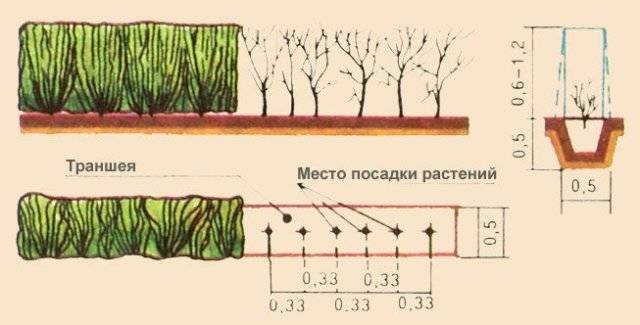

It is not recommended to plant a cotoneaster in three rows, because this form of planting can cause fungal infections and slow growth.
The cotoneaster can be planted in the fall, from late September to early November, that is, from the beginning of leaf fall until the first frost appears on the soil. Try not to delay the autumn planting, the seedlings should have time to take root before the cold weather. If you didn't manage to plant the hedge in the fall, it's okay, this can be done in the spring, before the buds begin to bloom on the seedlings.
If you plant purchased plants that were grown in pots, then planting can be done in the summer. For this, choose the weather not hot, cloudy and the first days after planting shade the young bushes from the scorching sun.
The cotoneaster does not require any special conditions for the soil composition and humidity. The only thing is, try to plant such a living fence in a sunny place.
First, decide on the territory where the hedge from the cotoneaster will be located, and remove all weeds with rhizomes on it.
You can dig a separate hole for each seedling, but it is better to make a continuous trench, this will be faster and more convenient. Make the depth at least 50 cm, because the root collar of the seedling must be completely hidden underground, and it should also be taken into account that in the future the root system will grow. The width of the trench or hole should also be at least 50 cm in size.
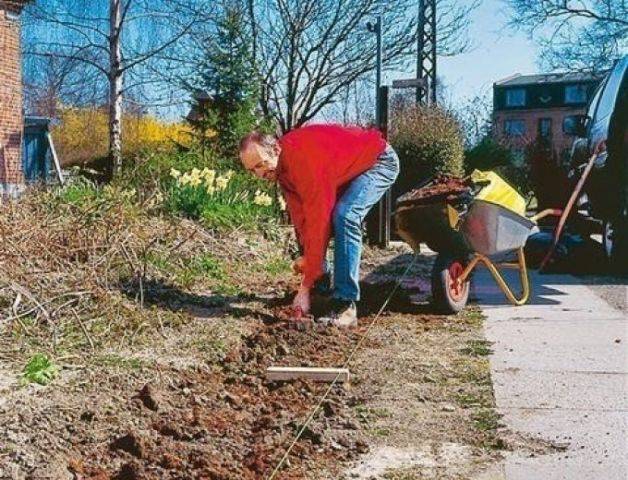

At the bottom of the dug hole, it is imperative to provide good drainage, for this, lay pieces of broken brick, gravel or expanded clay with a layer of 20 cm. This will prevent the root system of the bushes from decay.
Despite the fact that the cotoneaster does not require particularly fertile soil, for its better development, it is advisable to add a little humus, sand, peat and compost when planting. Mix these ingredients with regular earth. It is also recommended to add chalk or lime to the soil prepared for planting (300 g per 1 square meter will be enough).
Pour planting soil on top of the drainage, filling the hole by 1/3 of the volume. Place the seedling in the center, and then cover it with earth until the root collar of the bush is covered. Now you need to tamp, water and mulch the soil around the planted cotoneaster, foliage, peat, wood sawdust, mowed grass, coniferous needles are suitable for this.
Views
Despite the fact that there are a lot of species and varieties, not all of them take root in central Europe. Among the most common are no more than 10.
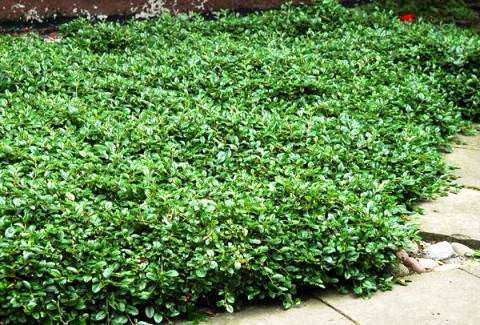

- Dammer's cotoneaster is very low, up to 10 centimeters, it just spreads along the ground, forming a cover with thick oval leaves. This species is good for decorating lawns, frost-resistant shrubs will decorate the landscape with beads of red fruits until snow appears. True, it grows slowly and prefers moist fertile substrates.
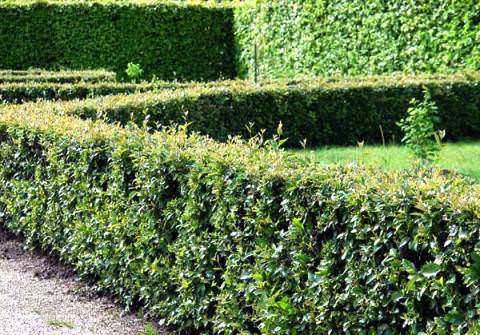

- The cotoneaster is brilliant. The species is quite frost-resistant, tolerates droughts well, loves bright light and grows remarkably even in ordinary city parks. The bushes are not very spreading, the crown is elongated. It will delight you with flowering at the end of May. It propagates by seeds, but their germination rate is no more than 15%. After about a year, it will begin to bush, and after two, the plant can already be transplanted. The view is good because the bushes are remarkably amenable to curly haircuts, this particular cotoneaster is one of the favorites in landscape design.
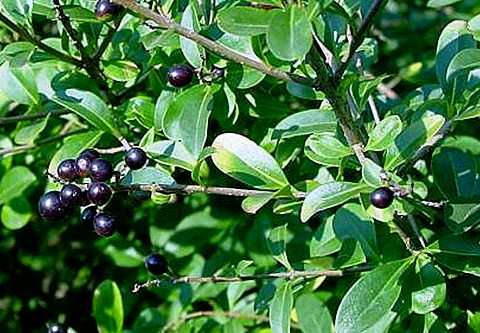

- Black cotoneaster can be confused with shiny, but it has larger leaves without glossy sheen. This is one of the tallest giants in the family, it can reach a height of 2.5 meters. It also keeps its shape perfectly and is suitable for creating a hedge.
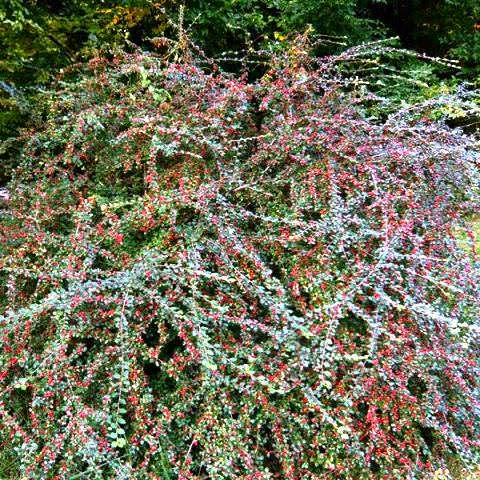

- Spread cotoneaster prefers open terrain and loamy soils. Differs in a dense crown and very beautiful decorative leaves. The height of the bushes is no more than a meter.They can be used to form round balls, lush "pillows", charming hemispheres. Suitable for decorating a rocky garden. Multicolored perennials and conifers are planted nearby as satellites. Often used for curbs.
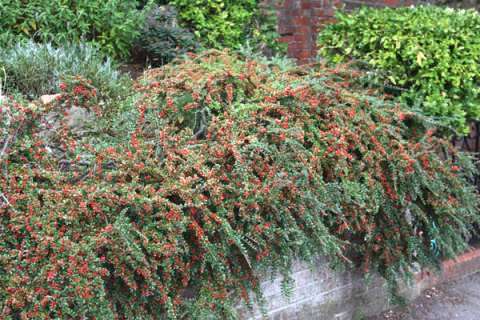

- The horizontal cotoneaster will be a great option for areas with harsh winters, it rarely freezes. Often it is planted singly, the evergreen shrub looks very beautiful thanks to the outstretched shoots, although it is low - only 50 centimeters. It is also used in dense group plantings, but in this case it will need a haircut. This will create well-groomed foreground thickets, especially when combined with conifers.
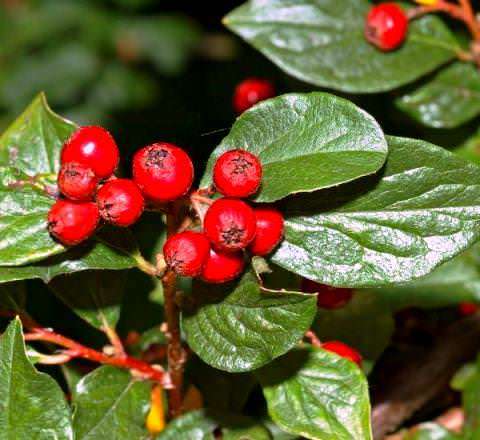

Care for all species consists in regular watering (it is worth focusing on the presence of natural precipitation), loosening at the foot and weeding. Of course, the shrub will appreciate the fertilization in the form of compost or humus.
Care
All cotoneaster care procedures are not particularly difficult.
After planting seedlings, during the first year, they need to be watered once every two weeks (it is clear that this means the spring-summer-autumn period). If it is very hot and dry in summer, then the frequency of watering should be increased.
In order for the hedge to always have a beautiful and well-groomed appearance, it is necessary to regularly trim the plant. The cotoneaster is that shrub with which you can safely experiment, giving any shape during a haircut. Even if you don't really like the new look of the hedge, don't worry, the plant grows back well.
To give clear forms when pruning shrubs, trellis shears and a rope are used.
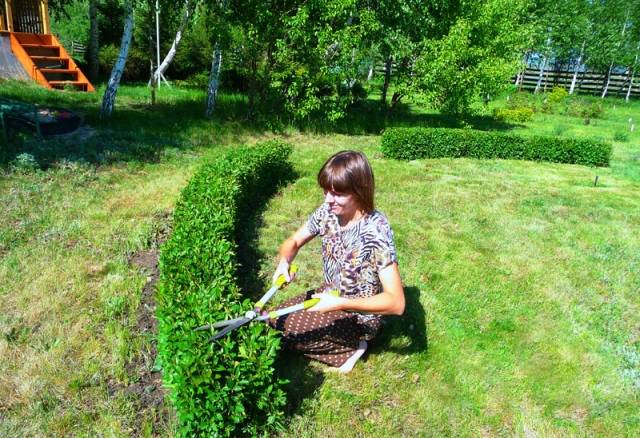

Do not forget about sanitary pruning, regularly remove damaged and dried branches, you can do this at any time of the year.
It is recommended to feed the shrub every year with the onset of spring. To do this, take 10 liters of water and dilute 1 tablespoon of urea or any other mineral fertilizers in it. Water the shrubs with the resulting solution. Once again, you can make top dressing in the second decade of May, just before the cotoneaster blooms. Add 60 g of superphosphate and 10 g of potassium sulfate for each square meter of soil.
Around young, newly planted plants, weed regularly, remove weeds, loosen the soil and mulch.
If the winters in your region are protracted and with severe frosts, it is advisable to protect the roots of young plants from freezing by mulching them or covering them with any covering material.
Reproduction of the brilliant cotoneaster
How to propagate a brilliant cotoneaster? There are two options for how the cotoneaster reproduces - by cuttings and by seeds.
If you choose to propagate a shiny cotoneaster with seeds, keep in mind that only half of the seeds involved will sprout. That is why long-term stratification should be carried out throughout the year before starting work. Collect the seeds in October in a metal container - and store outside or in the refrigerator. With the onset of the next autumn season, they can be used for plant propagation.
Attention! If you want to speed up this process, soak the seeds in sulfuric acid for about 20 minutes. Then they can be used in a month.
Immerse the seeds in warm water before planting. Those seeds that float are unsuitable for planting. Sow the soil by placing the seeds about 4 centimeters deep. The distance between them must be at least 15 centimeters.
The germination process of seeds can be delayed. Even if you follow all the recommendations of experts, the yield can be about 10 percent of the total amount of seeds. As for the speed of germination and growth, some shoots will appear only after a year.
How fast does a cotoneaster grow? In the first year, the plant will grow by about 30 centimeters, and after another year, a crown will form at the cotoneaster. For such bushes to start blooming, wait 4 years.
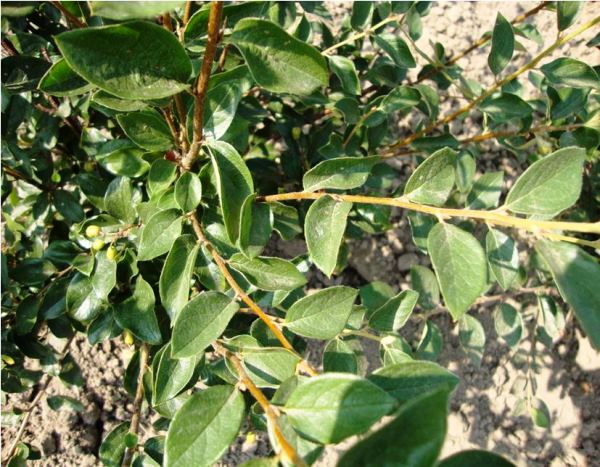

Brilliant cotoneaster, hedge: photo, growth rate
Now let's figure out how to propagate a shiny cotoneaster with cuttings. For grafting cotoneaster, you can use both green and lignified cuttings. In the first case, the reproduction of the cotoneaster takes place in July. Cuttings should have dimensions up to 15 centimeters and include at least two internodes.
How to cut a cotoneaster? First, place them in a growth-promoting solution for a few hours, and then plant them in the prepared soil in separate boxes. Form the soil on the basis of the same ratio of sod land, humus and sand. Weed well the soil in which the cotoneaster will grow.
Arrange the cuttings at a 45-degree angle - and place 5 cm into the ground. Cover with glass jars or wrap in plastic (you will have to constantly remove it to ventilate and water the plants).
With the propagation of a cotoneaster shining with cuttings, the root system will grow by the autumn season. Then you can move the plants to the area where the hedge is being formed. With the onset of cold weather, cover them with needles or dry foliage.
As for lingering cuttings, they should be cut off when cold weather sets in - and stored in a cool place in the sand. For spring, cut them into 20-centimeter pieces with three or more buds each. The further process will be the same as described above.
Formation
After the seedlings have been planted, they are allowed to grow freely for two years. And after this time, they begin to form a hedge.
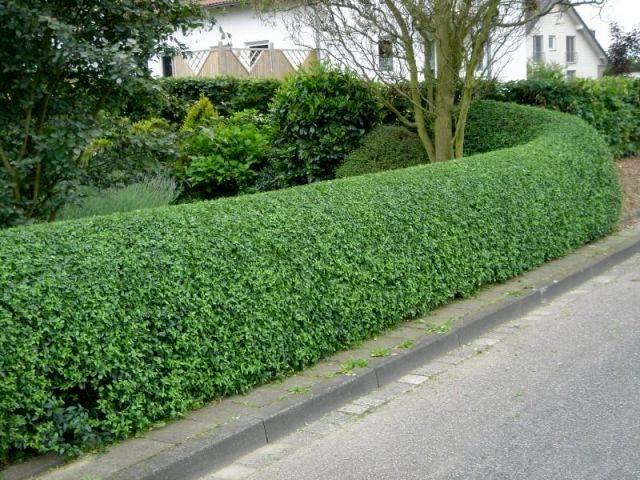

To begin with, the plant must be limited in height, this will cause a large growth of side shoots, the cotoneaster will begin to bush.
Initially, it is necessary to outline some kind of contour, to which the lateral shoots should be allowed to grow. As soon as they start to go beyond it, limit lateral growth. First, pinch the side branches, this will cause even more tillering. When the side branches begin to grow and go beyond the intended outline, cut them off.
You can shape the hedge as you wish. The lightest are considered square and rectangular. But trapezoidal and triangular hedges will already require effort and some experience. Especially skilled owners of hedges give them a wave shape or some bizarre figures.
Description
The brilliant cotoneaster (cotoneaster lucidus), which is part of the Rosaceae family, is one of the most suitable species for creating low hedges and borders.
Although it does not belong to evergreen crops, it retains its decorative appearance for most of the year. The crown of this ornamental shrub, reaching a height of 2 to 3 meters, is formed by erect branches with a large number of young leaves. Almost all types of cotoneaster have a creeping bush shape.
Small leaves (5 cm long, 3 cm wide) are elliptical. Their upper shiny surface is painted in a dark green shade, and the lower one is lighter and slightly yellowish. With the onset of autumn, the leaves turn purple-brown.
Pink flowers, collected in inflorescences such as a shield, from 5 to 11 pieces, give a special beauty to this type of cotoneaster. Flowering occurs in May - June. The tasteless black fruits with shiny skin and brown-red flesh ripen in September. Cotoneaster berries do not fall almost until the very frost.
Garden decoration
The cotoneaster in landscape design is used mainly for the middle and lower tiers, depending on the characteristics of the species.
Several ideas for application
1. Design of low hedges and borders.Shrubs are planted in straight lines in pre-dug trenches, but sometimes a checkerboard pattern in two rows is also used. They can be formed only after 2 years, before that they are left to grow freely. To achieve abundant tillering, the dormant buds below are "awakened" by simply pinching the growth points. Then, according to a similar principle, the lateral contours are also limited, and then the branches that protrude beyond the boundaries of the required shape are cut.
The edges will not be perfectly even right away, but only after a series of haircuts. As a result, you can get rid of extra branches only 4 times per season, the shape of the hedge or border will turn out to be dense and very effective.
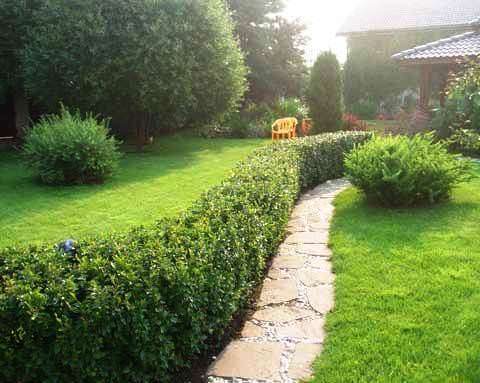

Such plantings can become a border for the lawn, they will help fence off the path to the entrance, create separate zones in the garden. If you decorate the cotoneaster border with a closed square or rectangle, and plant a composition of flowers in the center, it will turn out very elegantly.
2. Hemispheres, spherical and flat "pillows". Such compositions, distributed over a garden or lawn, combined into a single composition, located in mixborders, are considered elements of the Japanese style. However, they are beautiful in any area, as they create a sense of harmony and order. Naturally, the ornamental shrub will have to be trimmed systematically.
3. Covering the soil. A low-growing cotoneaster, for example, Dammer, will help arrange a shrub lawn. Such landings are cut only from above.
Leaves and fruits have medicinal properties. Decorating your garden with an ornamental plant, you can at the same time acquire a storehouse of natural medicines for a number of ailments.
Did you like the article? Vote! 11111 Rating 5.00
Landing place
To create a hedge, a well-lit place is chosen from a brilliant cotoneaster. But if this is not possible, then you can use the area in shallow shade.
It is desirable that the shrubs be lit for at least 3-4 hours a day. It is worth remembering that if you plant the bushes in the wrong place, then after 2-3 years they begin to develop poorly and quickly lose their beautiful appearance.
The size of the trench for planting hedges directly depends on the quality of the land on the site. If the soil is of good quality, then the depth and width varies from 0.5-0.7 m.
But if the land at the landing site is not suitable, then the depth and width of the trench should be 1 meter. It is worth considering that on clayey lands, drainage (15-20 cm) is necessarily poured at the bottom of the trench, which consists of gravel and sand. And where there is a lot of sand in the ground, a layer of clay (10-15 cm) is poured onto the bottom.
Diseases, pests
Like other ornamental crops, the cotoneaster is prone to disease. The most common is fusarium, it is manifested by yellowing of the leaf plate. If the cotoneaster is not treated in a timely manner, it will die.
Having found signs of fusarium, it is necessary to remove the affected parts of the plant, treat the soil and the shrub itself with a fungicide. We must not hesitate with the processing, as the cotoneaster may die! Sometimes a culture is attacked:
- spider mites;
- scabbards;
- aphid.
In the fight against pests, use a garlic tincture or a remedy prepared on the basis of potato tops. Infusion of yarrow also helps to expel insects. If folk remedies do not help, I advise you to use insecticides. The most popular drug is Actellic.
The advantage of the brilliant cotoneaster is that it is frost-resistant. The shrub is not covered in mild climates. If the winter is harsh and snowless, you should mulch the trunk circle using foliage. The thickness of the mulch layer should be 7 - 10 cm. Spunbond can be used as a covering material.
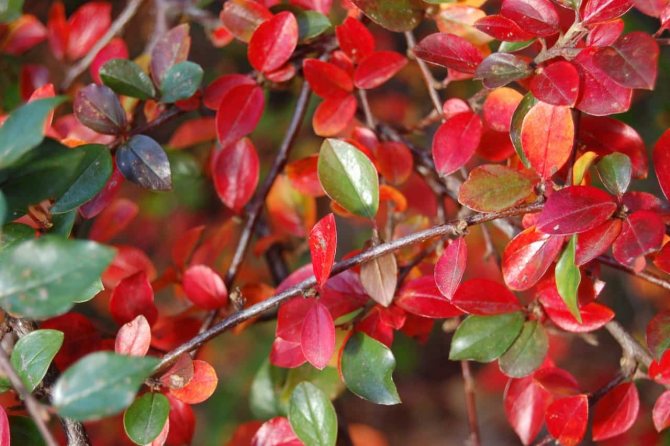

Planting time and soil
Although the cotoneaster is unpretentious to soils, it grows best on slightly acidic (pH 5.5-6.5), nutritious and permeable soil.
The mixture for filling the planting trench can be made up of rotted peat, sand and turf.
Moreover, sand and sod land need to be taken in two parts, and only one part of rotted peat. Planting can be done in spring and autumn.
Autumn planting time is much better than spring planting time, as there is more time for rooting. In spring, warm days can come pretty quickly, which is not very good for only planted plants.
Landing
If the root system of the seedlings is open (without a clod of earth and without a container), then planting is carried out either before the beginning of the growing season or after its end. But since now in garden centers most of the plants are sold in pots, planting can be carried out throughout the warm season.
Before planting, the seedlings are examined, the broken and dried branches are cut, straightened and the roots are slightly shortened. It is advisable to soak plants with open roots in a solution of heteroauxin (or any other stimulant for root formation) for 5-10 hours before planting.
Such preparations can be purchased at any garden or flower center. And container shrubs are spilled with a solution of heteroauxin after planting. One weather meter of the fence requires 10 liters of such a solution. This helps the seedlings take root quickly, improves their growth and development.
During planting, part of the soil is poured onto the bottom of the trench, then shrubs are placed in it (1 linear meter - 3 seedlings), the roots are evenly straightened and carefully covered with soil, making sure that all the voids between the roots are filled.
After the entire hedge is planted, the land around is slightly tamped, shed well and re-filled with the settled earth. It is imperative to ensure that the base of the bush is at ground level.
After planting, the cotoneaster is immediately cut to one third of the height. When planting in the fall, such pruning is carried out in the spring, but if the hedge is planted in the spring, immediately after it.
It is advisable to mulch the land around the shrubs with peat, humus, husks or wood chips. Moreover, the peat layer should be about 4 cm, and the rest of the mulching materials are poured in a layer of 8 to 10 cm. This will help to retain moisture and prevent the growth of a large number of weeds.
How to plant shrubs correctly
The size of the planting material (the height of the seedling) does not really matter, since the shrub grows quickly and to create a dense hedge, it still needs to be trimmed as soon as it takes root. Plants with ZKS can be cut off immediately after planting, this is especially true if the bush is one long twig. In this case, a haircut will serve as an incentive for thickening the shrub. In harsh winters with little snow, it is advisable to choose deciduous cotoneaster species, since evergreen varieties winter well only under snow cover.
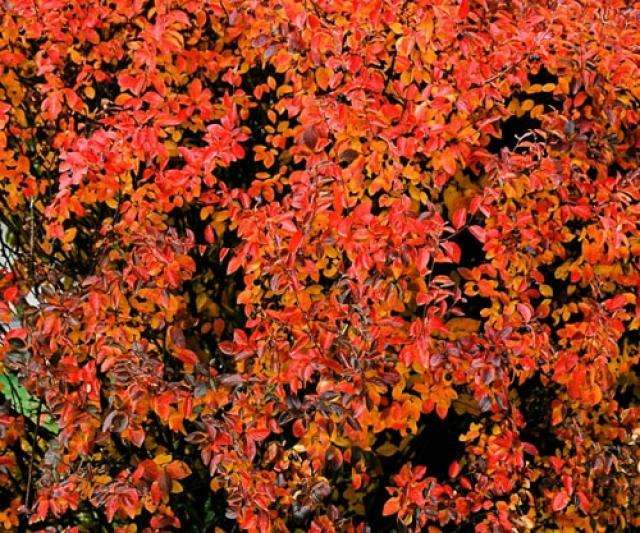

The autumn cotoneaster is replete with purple colors
Planting stages:
- Dig holes or trenches 60–80 cm in depth and width (equal to 2 bayonets of a shovel), taking into account the further growth of the root system.
- Lay expanded clay or gravel, a mixture of sand, turf and peat on the bottom.
Fertilizing during planting is optional, but compost can be added to the above mixture if desired. - Plant the plants according to the chosen scheme and avoid waterlogging.
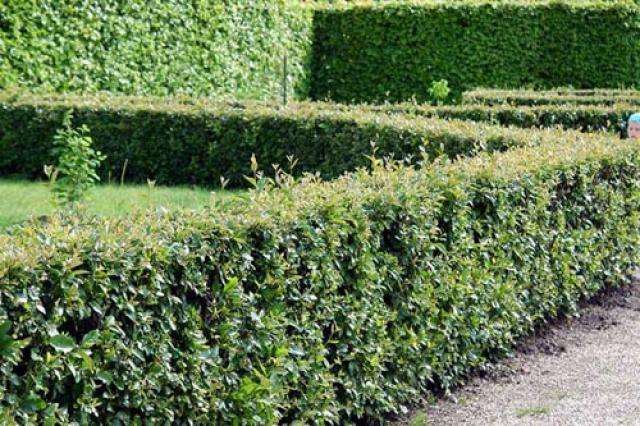

Regular haircut gives the fence the perfect shape
Pruning
In order for the hedge to be dense and dense, you need to properly shape it by trimming. In the first year of planting (in spring), it is necessary to shorten the apical branches by one third and strongly - long lateral shoots.
The next year, in the spring, all branches growing to the side are again reduced by a third of the length. And starting from the third year of cultivation, the hedge is cut in the form of a cone.
It is recommended to cut hedges from the brilliant cotoneaster immediately after flowering (May-June).Every spring, the shrubs undergo sanitary pruning, during which diseased, shriveled and broken branches are removed.
Cotoneaster hedge - beautiful multicolor in autumn and colorful berries in winter
Cotoneaster belongs to the group of shrubs of the Rosaceae family. It is ideal for garden decoration as it has good characteristics, including aesthetic ones. The shrub is perennial, growing and developing over fifty years, reaching a height of two meters - this is important when building a hedge.
The main characteristics of the variety include the following distinctive features:
- foliage, which has a simple geometric shape, elongated, oval. The leaves themselves are quite dense, which allows the plant to keep its shape, take the desired shape. The unique emerald shade of the leaves fits perfectly into any design idea, and evergreen varieties are able to retain their properties even in winter;
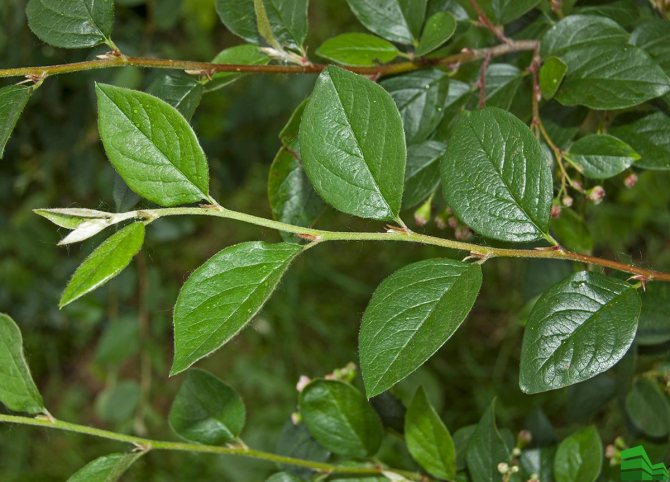

- flowers that appear on the plant at the end of May last for about two months. They have a pale pink hue and a pleasant unobtrusive aroma;
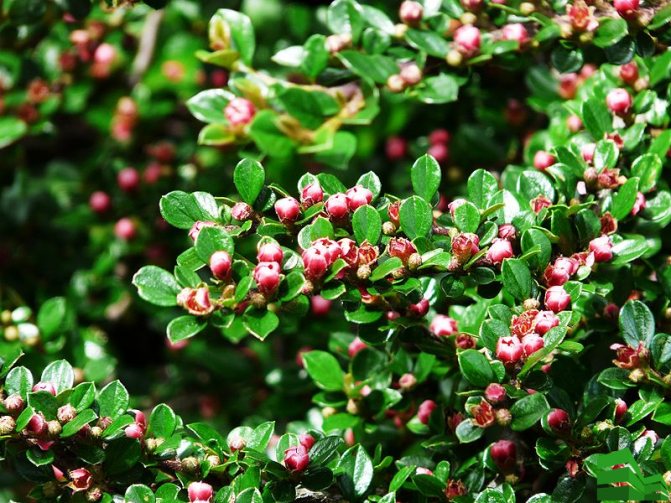

- black round berries, ripening by September, are suitable for medicinal purposes, for making tinctures, ointments. They are unsuitable for food, since they do not have a pronounced taste.


The brilliant cotoneaster is ideal for a hedge, while it is unpretentious, it easily gets along with other plants: spirea, rose hips and barberry. In addition, it has a number of distinctive advantages.
Watering and feeding
All hedge care consists of watering, loosening and fertilizing. Only young plants in the first two to three years of life need constant watering throughout the warm season.
Adult cotoneaster is regularly watered only in hot summer, when it does not rain for a long time. The rest of the time, watering is carried out as needed (two weeks before flowering, during intensive growth of branches).
When watering, you need to remember that it is better to do it less often, but abundantly and for a long time. If, with good watering, the deep layers of the soil are saturated with water, then this will be enough for the bushes for a long time. Frequent and short watering gives moisture only to the upper layer of the earth, but it does not reach the roots, and the plant suffers from a lack of water.
The destruction of weeds and loosening of the earth is carried out immediately after each watering or heavy rain to a depth of 5 to 8 cm.
The first time the shrubs are fed two months after planting (if it was carried out in the spring). If the planting took place in the fall, then the first feeding is carried out in the spring of the next year, when the plant starts to grow.
This is done so that the seedlings take root, and the root system grows, which provides nutrition. It is also worth remembering that in the year of planting, the dose of fertilizer is halved.
For the first spring top dressing, mineral fertilizers with nitrogen are used, which are scattered under the bushes and then sealed with a rake into the ground. But you can also mulch the soil around the bush with rotted manure in a layer of 6 to 8 cm.
Once again, it is advisable to feed the plants in the second half of summer. But in this case, it is better to use mineral fertilizers, which contain phosphorus and potassium. After each feeding, the hedge must be watered well.
How to care for a cotoneaster, see the gardener's tips in the following video:
Landscaping is quite popular today among the owners of country houses, cottages and backyard plots. In order to make our territory beautiful and stylish, someone resorts to the help of landscape designers, and someone studies information about certain plants and implements their own ideas.This article is dedicated to the Brilliant Cotoneaster, which is able to perfectly fit into the landscape of your site, as it is widely used as hedges, a crop for cutting various shapes, etc.
Diseases
The cotoneaster is rarely exposed to diseases, but sometimes the plant can still be attacked by an apple aphid, scale insect, plum sawfly or cotoneaster mite. To prevent this from happening, it is better to immediately take care of preventive measures. When setting up a hedge, choose a well-ventilated and open area.
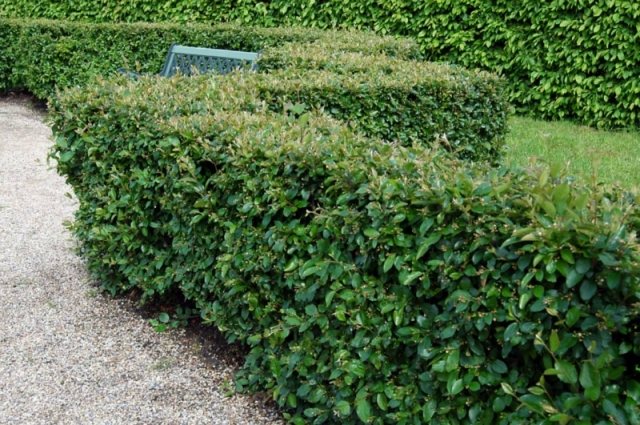

Inspect shrubs regularly. If young shoots are curved and have wrinkled leaves, these are the first signs of apple aphid. The disease can lead to complete drying of the shoot. Diseased branches should be removed immediately.
If pests and diseases do attack your cotoneaster, use tobacco, fungicides, yarrow and makhorka to fight the infection.
Sometimes the cotoneaster may be damaged by Fusarium. Diseased plant parts must be cut, burned and the soil disinfected. If the disease has affected large volumes of the hedge, then the planting site must be changed.


